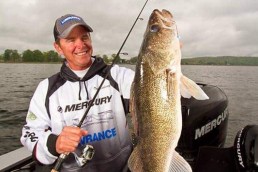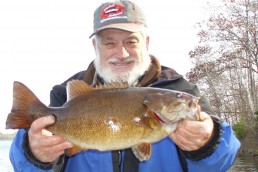Finding and Catching Giant Fall Smallmouths
SHARE THIS POST
When the first cold nights arrive at the end of August, the “feel” of fall begins to fill the air in central Minnesota. Hunters start to get their gear in order, and fishers are gearing up for the exciting fall bite.
As the water temperatures begin to drop in late summer, all fish begin to feed more often to fatten up for the winter months. Specifically, smallmouth bass form large schools and feed on many different types of bait. The fall smallmouth bite allows you to get on large schools of fish, and the most massive fish of the yer.
Location, food and temperature
It is common knowledge that smallmouths like rocks and hard bottom. This concept holds true in fall as well. However, all rocks are not created equal.
A locator such as the Lowrance HDS Live with detailed SideScan is extremely helpful when looking for the best rocks. SideScan allows you to analyze the size of boulders and just how big the rock pile is. Often, a hard-bottomed hump or break with have the “spot-on-the-spot.” The best spot in the right place is usually where the biggest rocks are close to each other and there’s a sharp break to deeper water. Here, smallmouths can slide up into the rocks and feed, and then slip down deeper to find shade and rest. Find a breakline or hump, and then find the biggest boulders on that spot and focus your attention in and around that area.
The depth of this fall activity can vary from place to place and lake to lake. Typically, the best fishing can occur from 5 to 20 feet of water. However, it could be shallower or deeper, depending on the body of water you are on.
When do smallmouth bass start to group and up feed? The best fall bite usually occurs when the water temperature is between 50 and 65 degrees. Remember, fish don’t use a calendar, so temperature runs their seasonal clock. At these temperatures, baitfish such as perch, shiners and other minnows slide back into the shallow structure from their summer locations. Smallmoutha capitalize on the abundance of bait, and it should be noted that minnows or small baitfish usually are their primary food source during the fall period.
Techniques
Drop shot—The drop-shot rig is a staple in most smallmouth fishermen’s bag of tricks. This versatile technique can be used all season long just by changing the size of the dropper weight and plastic of choice. Using a drop shot allows anglers to present the bait directly to the fish and keep it in their face. Often, the rig is slowly hopped along with bottom or fished vertically on deeper fish, keeping the weight in contact with the rock, but not dragging, as this will get snags. Using a tungsten dropper weight will help transmit the feel of the bottom much better than lead, but it is not a deciding factor.
Since smallmouths are primarily feeding on baitfish in fall, the right plastic for the job is usually something that mimics minnows. There are hundreds of minnow profile plastics out there, so choose what you have confidence in. If you are looking for a starting point, Berkley has developed the PowerBait Pro Twitchtail Minnow and the PowerBait The Champ Minnow for this specific application.They come in some incredible color patterns.
A drop-shot rig is best used once a school of smallmouths has been found, as it is not a fast fishing presentation.
Spinnerbaits
The spinnerbait is a classic bass snatcher, and it has been catching both large- and smallmouth bass since its introduction to the fishing world. Spinnerbaits can be fished fast or slow, deep or shallow. They come in large profiles or small profiles. Typically, larger-profile spinnerbaits are best in fall, and the weight will depend on what depth you are fishing.
Are you enjoying this post?
You can be among the first to get the latest info on where to go, what to use and how to use it!
Spinnerbaits are useful to cover water in high-percentage spots and catch active fish. As you are casting and fishing, take note of when a fish is caught and at what depth. If you find two fish close to one another, that is an indication that there is a feeding school. Slow down and make multiple casts in that area, or pick it apart with a drop shot or other slower presentation.
Crankbaits/twitch baits
Casting crankbaits and twitch baits is another way to cover water and locate hungry fish. Both of these presentations allow anglers to cover a variety of depths while triggering fish to bite. Crankbaits come in many shapes and sizes, but a good starting point would be the Berkley Bad Shad, Frittside, Dredger or Digger. These baits all have different actions but provide lots of vibration and a minnow profile that big smallies love in fall.
Twitch baits or slash baits can be great ways to trigger reaction bites from otherwise stubborn fish or to go searching for schools of bass. The most common baits in this category are the Rapala X-Rap and Berkley Skinny Cutter 110. Making long casts and working the lures back to the boat, twitching and pausing, mimics a wounded minnow. Many times, the bites will come when the bait is paused and suspended, so be ready.
Live bait
Fishing live bait can be extremely effective and relatively easy during this time of year. One of the best ways to fish for fall bass is a Lindy Rig and a big minnow. Minnow selection can vary, but if you can find big redtail or Creek Cubs, they are considered the fillet mignon of minnows. The downside to using chubs is that they are quite spendy and often hard to find. However, they are extremely hard workers and get bites. A secondary option is a sucker minnow, usually in the 4- to 8-inch range. Suckers are cheaper and in cold water stay pretty lively as well.
No matter what type of minnow you use, fishing a Lindy Rig along big boulders or transition areas can be a deadly way to catch smallmouth bass. One important note when fishing live bait is to avoid feeding the fish line before setting the hook, like fishing Lindy rigs for walleyes. Instead, let the fish pull on the minnow for a few seconds while keeping your bail closed. Once the rod tip has consistent pressure on it, you can set the hook, because bass will usually eat the minnow quicker than walleyes.
People who enjoy the outdoors have many options in fall to fulfill their passions. If you have not experienced smallmouth fishing in the later months of the season, you are missing out. The fish seem to fight harder because they are packing on the pounds for the winter months. The feeding windows are longer, and the weather can still be pretty awesome. Go to your favorite smallmouth river or lake and try some of these patterns; you will not be disappointed.
Become a MidWest Outdoors Insider here!
MWO
SHARE THIS POST
Did you enjoy this post?
You can be among the first to get the latest info on where to go, what to use and how to use it!
Tim Hanske
Tim Hanske is a guide and pro staffer with Leisure Outdoor Adventures, a premier fishing guide service in Walker, Minn. Check them out at leisureoutdooradventures.com or call 855-562-4665.



